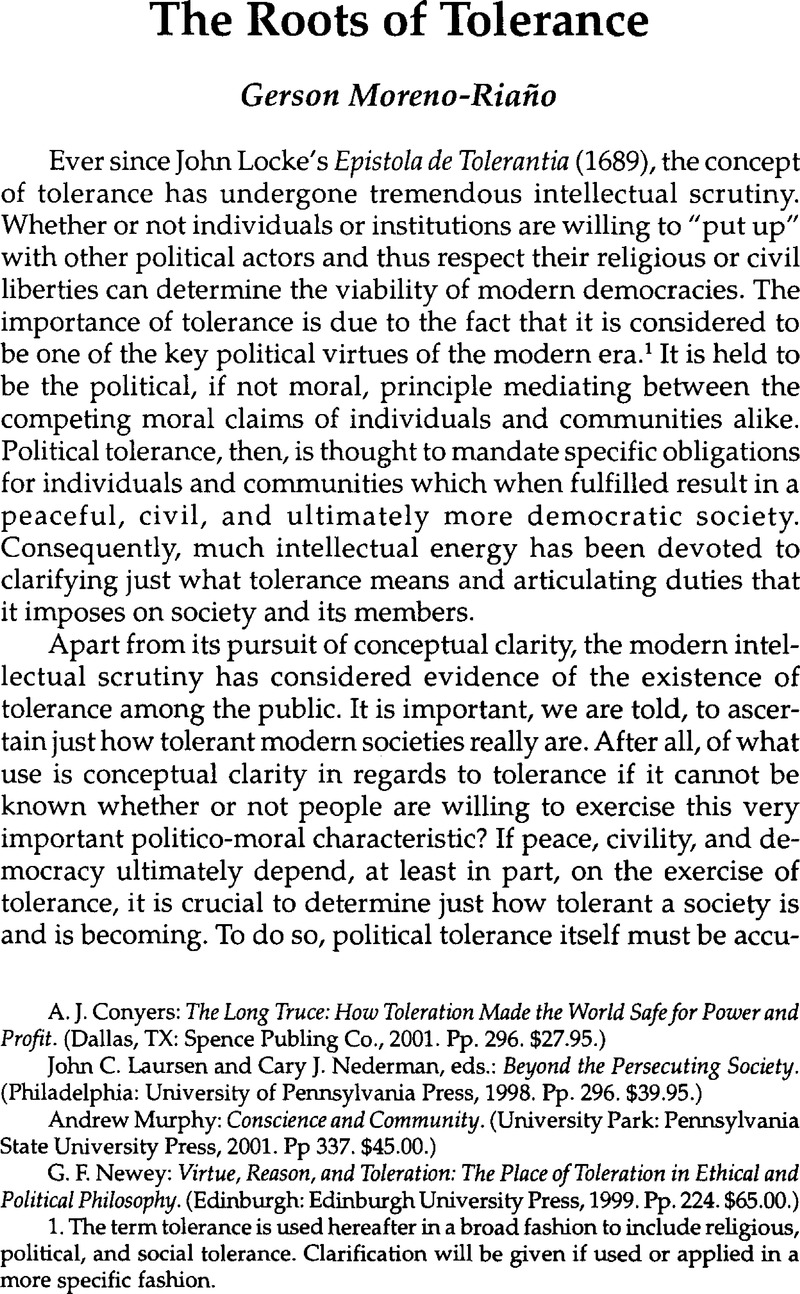Article contents
The Roots of Tolerance
Published online by Cambridge University Press: 05 August 2009
Abstract

- Type
- Research Article
- Information
- Copyright
- Copyright © University of Notre Dame 2003
References
Conyers, A. J.: The Long Truce: How Toleration Made the World Safe for Power and Profit. (Dallas, TX: Spence Publing Co., 2001. Pp. 296. $27.95.)Google Scholar
Laursen, John C. and Nederman, Cary J., eds.: Beyond the Persecuting Society. (Philadelphia: University of Pennsylvania Press, 1998. Pp. 296. $39.95.)Google Scholar
Murphy, Andrew: Conscience and Community. (University Park: Pennsylvania State University Press, 2001. Pp 337. $45.00.)Google Scholar
Newey, G. F.: Virtue, Reason, and Toleration: The Place of Toleration in Ethical and Political Philosophy. (Edinburgh: Edinburgh University Press, 1999. Pp. 224. $65.00.)Google Scholar
1. The term tolerance is used hereafter in a broad fashion to include religious, political, and social tolerance. Clarification will be given if used or applied in a more specific fashion.
2. For examples of these approaches see Stouffer, S., Communism, Conformity, and Civil Liberties (New York: Double Day and Company, Inc, 1955)Google Scholar; Sullivan, J. L., Piereson, J., and Marcus, G.E., Political Tolerance and American Democracy (Chicago: University of Chicago Press, 1982)Google Scholar. For a critique of these positions as well as a new approach to the study of political tolerance see Moreno-Riaño, G., Political Tolerance, Culture, and the Individual (Lewiston: Edwin Mellen Press, 2002)Google Scholar.
3. By applied history of ideas I mean to emphasize an approach which takes into account not only the historical development of intellectual ideas as seen in the works of great thinkers but also the historical development of these ideas within the tensions of an actual social and political milieu. This position resembles that advanced by Oberman, H.A.,“The Travail of Tolerance: Containing Chaos in Early Modern Europe,” in Tolerance and Intolerance in the European Reformation, ed. Grell, O.P. and Scribner, R.W. (Cambridge: Cambridge University Press, 1996), pp. 13–31CrossRefGoogle Scholar.
4. A partial exception may be granted to Newey's work due to its intensely philosophical nature.
5. An exception could be granted to Murphy as well as to Laursen and Nederman on the grounds that both attempt to debunk traditional Whig interpretations of history, particularly in regards to the development of tolerance as the historical realization of liberal progress.
6. Head, R. C., “Religious Coexistence and Confessional Conflict in Vier Dörfer: Practices of Toleration in Eastern Switzerland, 1525–1615” (pp. 145–168)Google Scholar; Way, H. F., “The Problem of Toleration in the New Israel: Religious Communalism in Seventeenth-Century Massachusetts” (pp. 251–278)Google Scholar.
7. Murphy suggests that his work attempts to explode three myths. First, the simplistic view that religious tolerance is a good and that opposition is ignorant and narrow minded. Second, that religious toleration is necessarily linked to Enlightenment skepticism. And, lastly, that religious tolerance can be generalized to contemporary issues of gender, race, and sexuality thus providing a base for identity politics.
8. For example, see Popkin, R.H., “Skepticism About Religion and Millenarian Dogmatism: Two Sources of Toleration in the Seventeenth Century,” in Laursen, and Nederman, , Beyond the Persecuting SocietyGoogle Scholar.
9. This position is advanced by Rawls, in Political Liberalism (New York: Columbia University Press, 1993)Google Scholar.
10. In The Long Truce, Conyers offers an exposition of the political thought of Thomas Hobbes, Pierre Bayle, and John Locke as contributing developers to the articulation of early modern tolerance as a political strategy.
11. In Conscience and Community, Murphy makes the same point regarding the religious roots of early modern tolerance. Conyers, though, hearkens to an earlier era and reaches a different conclusion regarding the application of this historical reality to contemporary debates and practice.
12. The ethical character of tolerance distinguishes it from its political manifestation. In other words, discussions regarding the place of tolerance in ethical theory consider its status as an individual moral quality. Political discussions usually focus on the consequential socio-political benefits of tolerant policies or individual behavior that is considered tolerant. Several important works have appeared regarding the status of tolerance within moral theory. Readers may wish to refer to Oberdiek, H., Tolerance: Betweèn forbearance and acceptance (Lanham, MD: Rowman and Littlefield, 2001)Google Scholar and Heyd, D., ed., Toleration: An Elusive Virtue (Princeton: Princeton University Press, 1996)Google Scholar.
13. Here it is instructive to note what Newey thinks tolerance encompasses. Tolerance involves an individual (T) having a reason (M1) for disapproving of another individual's (Y) doing of a certain activity (P). Further, tolerance also involves that T has another reason (M2) for not taking action to prevent Y from doing P and, lastly, that T has another reason (R3) which in other circumstances warrants T preventing actions of which T disapproves. This meta-theoretical approach to theories of tolerance is to set forth the conditions that an act has to fulfill in order for it to qualify as an act of toleration (pp. 18–52). Implicit in these conditions is the deliberative character of moral action which Newey defends as necessary for accounting tolerance as a virtue.
14. See above note 13.
15. Newey considers several philosophical justifications (e.g., the ethics of belief, value-pluralism, etc.) for political tolerance and finds them wanting. See chapter four “Toleration and political justification.”
16. The problem of treating political morality as isomorphous to individual morality is evidenced in Plato's, RepublicGoogle Scholar. On an excellent treatment of this issue, to which I am indebted, see Vlastos, G., “The Argument in the Republic that ‘Justice Pays’,” Journal of Philosophy 65 (1968): 665–74CrossRefGoogle Scholar; “Justice and Psychic Harmony in the Republic,” Journal of Philosophy 66 (1969): 505–21CrossRefGoogle Scholar; and “Justice and Happiness in the Republic,” in Plato: A Collection of Critical Essays, ed. Vlastos, , volume 2 (Garden City: Anchor Books, 1971), pp. 66–95CrossRefGoogle Scholar.
- 3
- Cited by


